
Gomoku, also called Five in a Row, is an abstract strategy board game. It is traditionally played with Go pieces on a 15×15 Go board while in the past a 19×19 board was standard. Because pieces are typically not moved or removed from the board, gomoku may also be played as a paper-and-pencil game. The game is known in several countries under different names.

Tic-tac-toe, noughts and crosses, or Xs and Os is a paper-and-pencil game for two players who take turns marking the spaces in a three-by-three grid with X or O. The player who succeeds in placing three of their marks in a horizontal, vertical, or diagonal row is the winner. It is a solved game, with a forced draw assuming best play from both players.
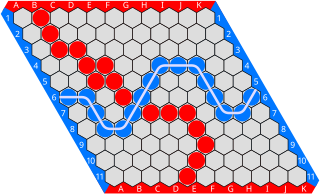
Hex is a two player abstract strategy board game in which players attempt to connect opposite sides of a rhombus-shaped board made of hexagonal cells. Hex was invented by mathematician and poet Piet Hein in 1942 and later rediscovered and popularized by John Nash.
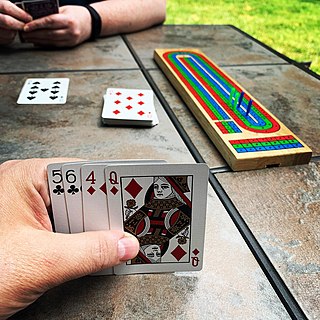
Cribbage, or crib, is a card game, traditionally for two players, that involves playing and grouping cards in combinations which gain points. It can be adapted for three or four players.
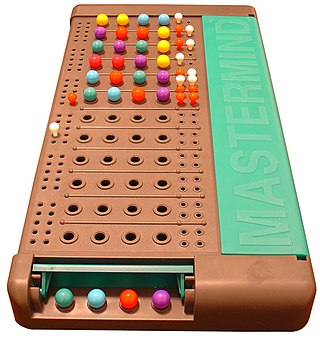
Mastermind or Master Mind is a code-breaking game for two players invented in Israel. It resembles an earlier pencil and paper game called Bulls and Cows that may date back a century.
A Gamut of Games is an innovative book of games written by Sid Sackson and first published in 1969. It contains rules for a large number of paper and pencil, card, and board games. Many of the games in the book had never before been published. It is considered by many hobbyist gamers to be an essential text for anyone interested in abstract strategy games, and a number of the rules were later expanded into full-fledged published board games.

Havannah is a two-player abstract strategy board game invented by Christian Freeling. It belongs to the family of games commonly called connection games; its relatives include Hex and TwixT. Havannah has "a sophisticated and varied strategy" and is best played on a base-10 hexagonal board, 10 hex cells to a side.
The pie rule, sometimes referred to as the swap rule, is a rule used to balance abstract strategy games where a first-move advantage has been demonstrated. After the first move is made in a game that uses the pie rule, the second player must select one of two options:
- Letting the move stand. The second player remains the second player and moves immediately.
- Switching places. The second player becomes the first-moving player with the move already done by the opponent, and the opponent plays the first move of their new color.

Battleship is a strategy type guessing game for two players. It is played on ruled grids on which each player's fleet of warships are marked. The locations of the fleets are concealed from the other player. Players alternate turns calling "shots" at the other player's ships, and the objective of the game is to destroy the opposing player's fleet.
The Shannon switching game is a connection game for two players, invented by American mathematician and electrical engineer Claude Shannon, the "father of information theory" some time before 1951. Two players take turns coloring the edges of an arbitrary graph. One player has the goal of connecting two distinguished vertices by a path of edges of their color. The other player aims to prevent this by using their color instead. The game is commonly played on a rectangular grid; this special case of the game was independently invented by American mathematician David Gale in the late 1950s and is known as Gale or Bridg-It.
Combinatorial game theory measures game complexity in several ways:
- State-space complexity,
- Game tree size,
- Decision complexity,
- Game-tree complexity,
- Computational complexity.

Golf is a card game where players try to earn the lowest number of points over the course of nine deals.
Star is a two-player abstract strategy board game developed by Craige Schensted. It was first published in the September 1983 issue of Games magazine. It is a connection game similar to Hex, Y, Havannah, and TwixT. Unlike these games, however, the result is based on a player having a higher final score rather than achieving a specific goal. He has since developed a slightly more complicated version called *Star with better balance between edge and center moves, writing "*Star is what those other games wanted to be."
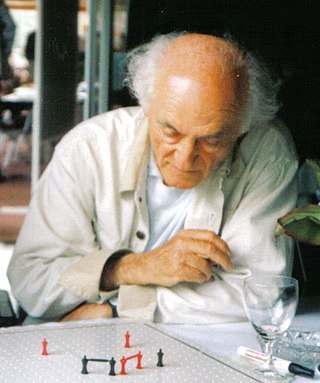
Alexander Randolph was a Bohemian-American designer of board games and writer. Randolph's game creations include TwixT, Breakthru, Hol's der Geier, Inkognito, Raj, Ricochet Robot, and Enchanted Forest.
A social game or, less commonly, parlour game, may refer to tabletop, other face-to-face indoor or outdoor games, or video games that allow or require social interaction between players as opposed to games played in solitude, games played at tournaments or competitions or games played for money.
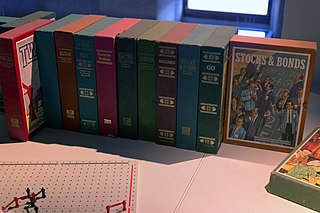
The 3M bookshelf game series is a set of strategy and economic games published in the 1960s and early 1970s by 3M Corporation. The games were packaged in leatherette-look large hardback book size boxes in contrast to the prevalent wide, flat game boxes. The series grew to encompass over three dozen games. Most were multi-player board games or card games; a few were trivia games or two-handed board games. Acquire and TwixT were among the best-selling titles. The series later became part of the Avalon Hill Bookcase games. Very few of these games are still being published.

Breakthru is an abstract strategy board game for two players, designed by Alex Randolph and commercially released by 3M Company in 1965, as part of the 3M bookshelf game series. It later became part of the Avalon Hill bookcase games. It is no longer in production. The game has been compared to Fox and Hounds, although it shows more characteristics of the Tafl games of the Middle Ages, such as Hnefatafl.

Oh-Wah-Ree is a mancala variant designed by Alex Randolph and published in 1962 by 3M as part of their bookshelf game line. The name "Oh-Wah-Ree" is taken from Oware, a typical West African game for which it is based on. It is played on a board with a ring of pits and stone playing pieces, distinguished from other mancala variants by the use of a second ring of holes to mark ownership of pits by the players, allowing play between more than two players at a time. The object is to capture the opponents' stones.
A connection game is a type of abstract strategy game in which players attempt to complete a specific type of connection with their pieces. This could involve forming a path between two or more endpoints, completing a closed loop, or connecting all of one's pieces so they are adjacent to each other. Connection games typically have simple rules, but complex strategies. They have minimal components and may be played as board games, computer games, or even paper-and-pencil games.

















